The Passenger Economy – when drivers are gone and we all travel around in driverless vehicles – will grow from $800 billion to $7 trillion globally by the middle of this century, says Intel, the American multinational technology company based in Santa Clara, California. According to a study carried out by Intel and Study Analytics, a new passenger economy will emerge to “support the idle time when drivers become riders.”
During ‘idle time,’ workers do not produce anything. If you are driving a car, for example, you cannot get on with your work. This is not the case if you are a passenger.
The passenger economy will be more than twice as big as the sharing economy, the study authors forecast.
Mobility-as-a-Service will completely transform long-held patterns of car maintenance, operations, usage, and ownership.
Regarding the new study, titled “Accelerating the Future: The Economic Impact of the Emerging
Passenger Economy”, its authors predict that the passenger economy will be worth $800 billion in 2035, and will reach $7 trillion by 2050.
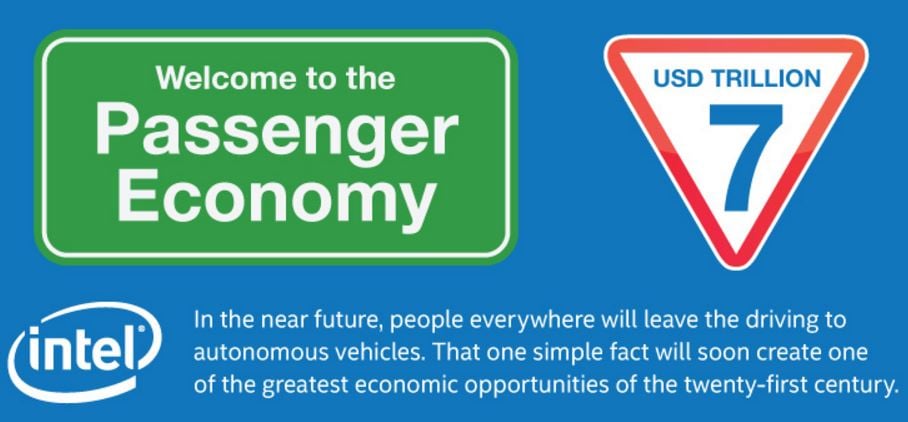 Business leaders who adapt to the transformation will survive, while those who don’t will fall by the wayside. (Image: newsroom.intel.com)
Business leaders who adapt to the transformation will survive, while those who don’t will fall by the wayside. (Image: newsroom.intel.com)
According to history, technology has always been the catalyst for major societal transformation. Businesses that adapted during those transformations have tended to thrive, while those that did not failed and were seen no more.
New digital business models that have sprung up since the birth of personal computing, ubiquitous connectivity, smartphones, and the Internet have completely transformed the global business environment.
In this context, ubiquitous refers to everybody being able to connect whenever they like from wherever they want.
The authors of the new report believe that autonomous driving – driverless cars – will do the same.
Brian Krzanich, Intel’s Chief Executive Officer (CEO), said:
“Companies should start thinking about their autonomous strategy now. Less than a decade ago, no one was talking about the potential of a soon-to-emerge app or sharing economy because no one saw it coming.”
“This is why we started the conversation around the Passenger Economy early, to wake people up to the opportunity streams that will emerge when cars become the most powerful mobile data generating devices we use and people swap driving for riding.”
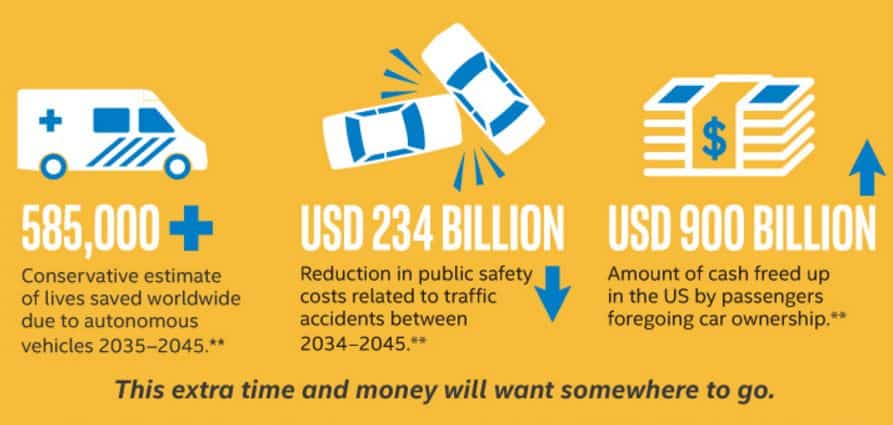 All those billions of dollars will need to go somewhere – enterprising individuals will try hard to make some of it come their way. (Image: newsroom.intel.com)
All those billions of dollars will need to go somewhere – enterprising individuals will try hard to make some of it come their way. (Image: newsroom.intel.com)
From a sharing to a passenger economy
At the beginning of this century, who would have thought there would be smartphones with apps for peer-to-peer and ride-hailing services such as Lyft and Uber? There has been a sea change in how individuals and businesses view transportation.
These transforming behaviors are combining with increasing urbanization, almost universal access to high-speed mobile broadband, and breathtaking leaps in computing power and data center capacity to enable these new business models to push forward the development and use of autonomous mobility solution.
Urbanization refers to the migration of people from the country to the city.
Being driven by pilotless vehicles that are controlled by artificial intelligence (AI) will represent the essential nature of future transportation.
First there was the private car owner economy, then the sharing economy, next we will have the passenger economy. Many scientists and AI specialists today are predicting that babies born this year will never drive a car. By the time they reach their late teens, when they would be thinking of getting their driving license, driverless cars will control our roads.
Passenger economy will change whole industries
Smart city technologies and autonomous driving will enable the new passenger economy – gradually changing whole industries and creating new ones.
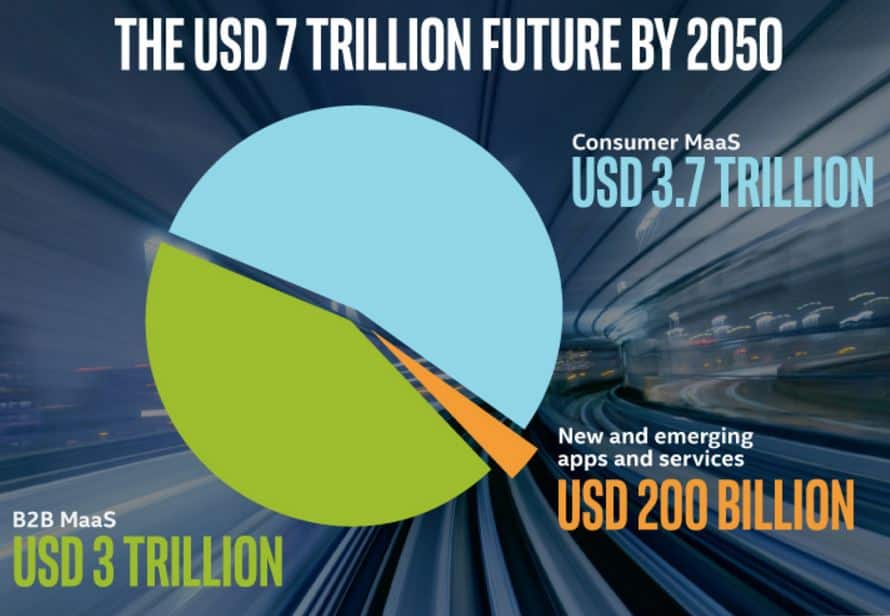 Three giant sectors – that do not exist today – will exist soon. The Consumer MaaS, the B2B MaaS, and New/Emerging-Apps/Services. (Image: newsroom.itel.com)
Three giant sectors – that do not exist today – will exist soon. The Consumer MaaS, the B2B MaaS, and New/Emerging-Apps/Services. (Image: newsroom.itel.com)
Regarding how we travel around in the future, urbanist and mobility futurist Greg Lindsay, said:
“Not unlike the space race of the 1960s, today’s announcement is a rallying cry to the world to put its best minds on this challenge. The future of mobility, economic advancement and the emergence of new growth opportunities like the Passenger Economy demand ongoing dialogue.”
“I am excited to partner with Intel, take this discussion on the road and look at solutions through the lens of the diverse industries that will shape our future – from automakers to investors and policy makers to startups.”
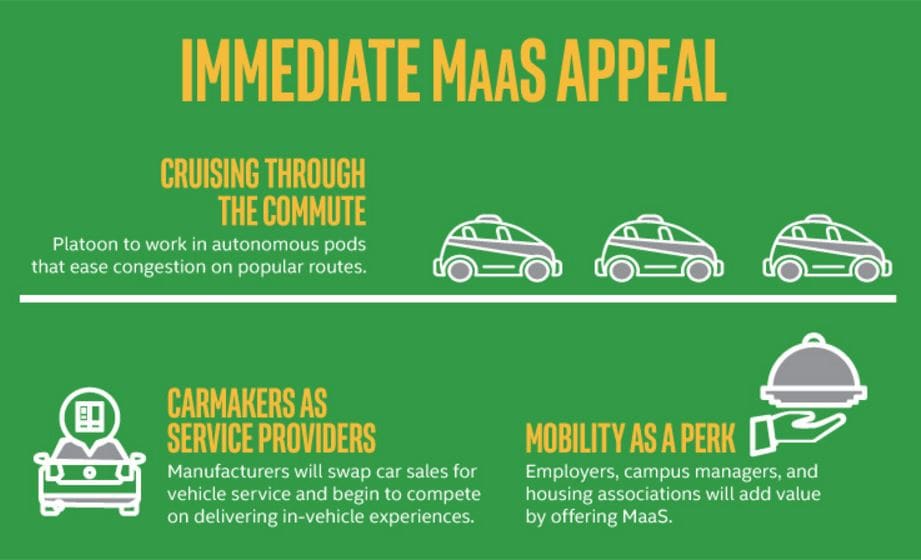 Humans will view passenger vehicles very differently in future. The pleasure (or unpleasantness) will not be in driving the car, but the experiences you can have in it. Vehicle makers will be offering a wide range of extra services. (Image: newsroom.intel.com)
Humans will view passenger vehicles very differently in future. The pleasure (or unpleasantness) will not be in driving the car, but the experiences you can have in it. Vehicle makers will be offering a wide range of extra services. (Image: newsroom.intel.com)
Key report highlights:
– Business use of MaaS (Mobility-as-a-Service) is forecast to generate $3 trillion in revenue, i.e. 43% of the total passenger economy.
– Consumer use of MaaS is predicted to generate $3.7 trillion in revenue, i.e. almost 55% of the total passenger economy.
– Pilotless Vehicle Services will expand and evolve. Rising consumer usage of new innovative services and applications that will emerge will be worth approximately $200 billion in revenue.
– Safer for travelers. The authors ‘conservatively’ estimate that self-driving vehicles can save 585,000 lives between 2035 and 2045.
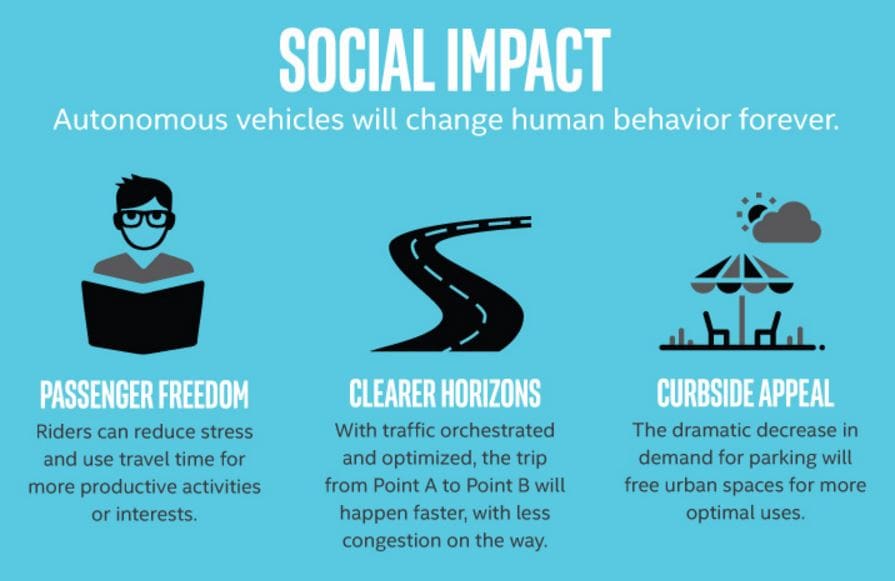 Human behavior will change dramatically. Traveling will be relatively stress free. Getting from point A to B will be faster. There will be much less demand for parking in cities, this will free up space for more pleasant uses. Road rage will be something people learn about from their history books. (Image: newsroom.intel.com)
Human behavior will change dramatically. Traveling will be relatively stress free. Getting from point A to B will be faster. There will be much less demand for parking in cities, this will free up space for more pleasant uses. Road rage will be something people learn about from their history books. (Image: newsroom.intel.com)
– Commuting Time will become free time, which consumers will be able to use for leisure activities, work, education, etc. In the world’s most congested cities, more than 250 million hours of consumers’ commuting time annually will be freed.
– Public Safety Costs related to traffic accidents will be slashed. The savings could amount to over $234 billion from 2035-2045 – during the passenger economy era.
Car-venience – cars will become transportation experience pods. There will be mobile health care clinics, remote vending devices, fast-casual dining, on-board beauty salons, and even platooning pod hotels.
– Mobility-as-a-Perk – apartment complexes, employers, office buildings, college campuses, and housing estates will offer MaaS to distinguish their offer from rivals, or add value as part of their compensation package.
Video – Passenger Economy
This short Intel Newsroom video provides some dates and figures to illustrate the expected impact of the passenger economy.
